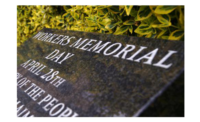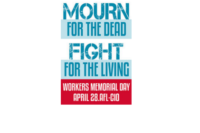Getting ready for Workers Memorial Day 2017

Source: https://uaw.org
Ralph Butler was the most senior skilled trades electrician at Freightliner’s Cleveland, North Carolina, assembly plant. He and a co-worker were responsible for maintaining equipment on the loading docks. On July 13 they were troubleshooting a dock leveler. After working the controls and observing dock plate motion, Butler went in for a closer look. Then he used a pry bar to push a hydraulic motor’s plug back into a receptacle. The dock plate appeared to be lowered all the way but when the hydraulic unit was re-energized, the plate came down just a few inches more, crushing him. He died eight days later in the hospital.
UAW skilled trades often need the power on to observe where the machinery is malfunctioning; the problems can’t be determined with the power off. The deadliest conditions lie in the gray area between full-energy isolation (Lock Out/Tag Out, also known as LOTO) and troubleshooting. With complex and sometimes poorly designed equipment, the problems are hidden; guards must be removed to reveal jams, robot cells must be entered to observe problems up close, control logic for automation must be studied. All this takes time. When a complex piece of machinery breaks down, our skilled trades are always faced with the pressure to get the machine back up and running as quickly as possible. But an “alternative means of control” for each hazard must be in place before proceeding. No one with training and a thorough understanding of the equipment should have to face these hazards.
Developing and sharing those safe work methods are everyone’s responsibility. This means pointing out hazards when you see them, speaking out about the way the work really gets done and fighting for safer methods. In a 2016 letter sent to all UAW locals President Dennis Williams wrote:
“All of us have to be our brothers’ and sisters’ keepers when it comes to health and safety. It’s not enough to personally follow health and safety rules. When we observe someone putting themselves or others in jeopardy, we must speak out. It’s literally a matter of life or death.”
Workers Memorial Day is a somber reminder that working safely doesn’t happen by accident. Preparation is a critical part of maintaining the health and safety of our members. In the last 30 months, six UAW members have lost their lives because of faulty Lock Out/Tag Out (LOTO) procedures, machine-guarding failures and the failure to follow safety procedures. Our union’s collective and concentrated efforts are needed to safeguard everyone. We must:
- Involve the union safety committee in Lock Out/Tag Out (LOTO) review.
- Consult every worker who conducts servicing tasks on how to improve the lock out system and robot cell entry procedures. Ask the question, “Which tasks involve risk and have the potential to bring harm to our co-workers?” Then ensure that the risks are eliminated.
- Ensure production workers who must unjam equipment or interact with robotics have control measures and guarding in place to protect them. No one should be entering a robot cell without being fully protected and trained on the proper entry procedures so that no body part is placed in machinery unless energy is controlled.
- Push management for updated controls such as inherently safe circuits on logic controllers, up-to-date e-stops that meet the latest safety standards and inherently safe robot troubleshooting procedures.
- Use effective energy control procedures and stop the inappropriate use of light curtains, presence-sensing devices or gate interlocks for lock out.
It is our responsibility to follow safety procedures but it is also our responsibility to look out for our brothers and sisters, especially if they are taking dangerous shortcuts. It doesn’t matter if they are trying to get the job done in a timeframe set by management. Safety comes first — always!
As President Williams wrote:
“UAW-represented facilities take great pride in efficiency and continuous improvement. But the union’s support of modern operating agreements that include flexibility and teamwork does not mean that we eliminate safety resources. If Lock Out /Tag Out takes time away from production so be it; we cannot cut corners and perform unsafe work. The cost of life and limb is too high.”
It is imperative that all workers return home to their family safe and sound, alive and healthy.
Mourn for the Dead — Fight for the Living
What Local Unions Can Do on Workers Memorial Day
Organize a rally to call for stronger safety and health protections. Demand that elected officials put workers’ well-being over corporate interests.
- Hold a candlelight vigil, memorial service or moment of silence to remember those who have died on the job and highlight job safety problems at workplaces in your community.
- Hold a public meeting with members of Congress in their districts. Bring injured workers and family members who can talk firsthand about the need for strong safety and health protections, and the freedom to join a union. Invite local religious leaders and other allies to participate in the meeting.
- Conduct workshops to empower workers to report job safety hazards and exercise workplace rights. Invite union members, nonunion workers and community allies to participate.
- Create a memorial at a workplace or in a community where workers have been killed on the job.
Invite the press to your Workers Memorial Day events to increase public awareness of the dangers workers face on the job.
Looking for a reprint of this article?
From high-res PDFs to custom plaques, order your copy today!








